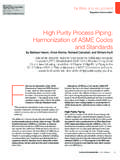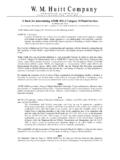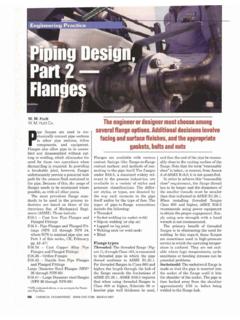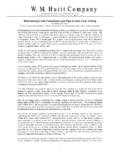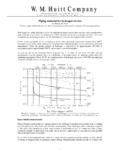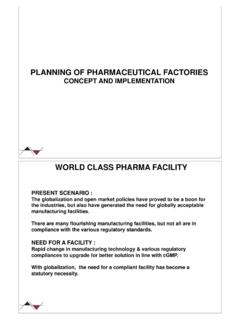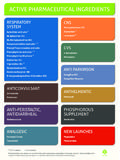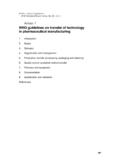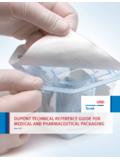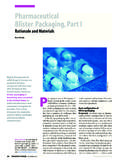Transcription of ASTM and ASME-BPE Standards and the …
1 1 W. M. Huitt W. M. Huitt Co. Across the wide spectrum of the more than 200 American National Standard (ANS) Developers, those organizations accredited by ANSI (American National Standards Institute) to develop industry Standards , and the more than 10,000 American National Standards that are published by those ANS developers, there is an ongoing and dynamic effort to ensure harmonization among the many Standards . Two ANS developers that directly impact the pharmaceutical industry are the American Society of Mechanical Engineers ( asme ) and astm International, formerly known as the American Society for Testing and Materials ( astm ). As a result of this harmonization effort the engineer of an API (Active Pharmaceutical Ingredients) facility can readily make use of multiple Industry Standards on a single project without concern of conflicting statements between those Standards .
2 That is not to say that a more stringent requirement will not exist in one Standard over another. This is normally rectified by including, in proprietary specifications and guidelines, a statement to the effect that, the more stringent requirement shall govern . In adopting industry Standards , such as those published by asme and astm , an engineer is drawing upon the consensus of committees of experts in which the results of pertinent subject matter have been assessed, analyzed, debated, and voted on at multiple levels, culminating in accredited standardization. Not only is the content of these industry Standards arrived at through a rigid internal process, but also through inter-standard communication.
3 What this means for the end user is this: Unless a project is regulated by a specific Code that has been adopted as a Federal, State, or municipal regulation, you may specify, through contract stipulation or project specifications, the requirement to comply with a particular set of Codes and Standards . These requirements may specify, as an example, asme Process Piping as the main compliance piping Code for a project, with or without exceptions. Additionally, the project requirements will dictate the need to reference Codes and Standards beyond those requirements captured in Such requirements will include Standards for components and material of construction (MOC), as well as specialized needs such as those carried in the asme BPE (Bioprocessing Equipment) Standard.
4 In the case of the component related Standards , these are generally adopted as a whole with optional requirements within the particular Standard that need to be specified in the procurement documentation. The same holds true with material Standards published by astm . These Standards too are adopted as a whole with optional requirements within the Standard that need to be specified in the procurement documentation. When using a piping Code such as as a base Code for a project other piping Codes and Standards can be referenced for compliance when the following occurs: 1. The referenced requirement is not already contained in the base Code, 2. The referenced requirement is more stringent than that contained in the base Code, Without harmonization between the various [American National Standards ] Developers the usefulness of industry Standards would most likely be diminished by conflicting requirements and overlapping stipulations.
5 AASSTTMM aanndd AASSMMEE--BBPPEE SSttaannddaarrddss aanndd tthhee PPhhaarrmmaacceeuuttiiccaall IInndduussttrryy 2 Figure 1 Venn Diagram of codes & Standards requirements 3. The referenced requirement does not conflict with a not permitted statement in the base Code. Such as: a. Para. (c) A flared lap is not permitted under severe cyclic conditions. This discussion thus far leads me to make the point that even though a project has adopted a base piping code, either by the authority of government regulation or by engineering decision, it is beneficial and even necessary for the engineer to look to other Standards in defining additional requirements a project will need beyond those covered in the base code.
6 Rather than a company spending time and money defining needed requirements not covered by , as an example, look to other Standards in which vetted requirements matching a project s needs may already exist. What a project s Codes & Standards requirements may look like graphically is represented in the rather simplistic Venn diagram of Fig. 1. What this shows is a basic representation of the possible piping Codes and Standards needed for an API type project and how they overlap and comingle within the framework of a project, or within the infrastructure of plant operations and maintenance. In actuality this graphic would be a great deal more complex due to the sheer volume of Codes and Standards a project or plant operations would require.
7 astm Working with the Pharmaceutical Industry A key factor in achieving hygienic conditions for manufacturing pharmaceutical grade products is in the material that comes into direct or indirect contact with the product. The workhorse material in this industry is 316L stainless steel under the astm Standard A270-S2. Because the welders and welding operators performing circumferential buttwelds for hygienic piping are required to make acceptable autogenous welds (welds without filler metal) on a repeatable basis under closer tolerances and additional scrutiny than general piping requires, the majority of those welds are accomplished with semi- 3 automated welding machines called orbital welders.
8 Achieving repeatability with orbital welders requires that the material of the two components to be welded have very similar chemistries; in particular their sulfur content. Until as recently as the mid 1990 s engineers designing a pharmaceutical grade facility had to specify, and fabricators had to match, heat numbers on tubing and components that were to be welded together. This time consuming exercise in specifying, locating, ordering, verifying, and stocking tubing and components with these matching heat numbers was, at times, a logistical nightmare; not to mention the added cost in performing this effort. The heat number itself is a tracking number for metallic material that allows the material to be traced back to its original chemical composition at the time of its formulation in the mill.
9 Documentation, in the form of Material Test Reports (MTR s), is one part of the rigid documentation records required when building a pharmaceutical manufacturing facility. The MTR provides certification of the chemical composition of the material along with the heat number to validate that data. The reason for going to all the trouble of matching up heat numbers was instigated by the need to match up compatible sulfur content within the material composition. That information is included in the MTR. Without getting too far off topic, the amount of sulfur content in the metal affects the weld pool. A high level of sulfur (sulfur having a high electron affinity) instigates a re stricted anode spot at the weld providing excellent penetration.
10 Lower sulfur content instigates a diffuse anode spot at the weld causing less penetration and a wider weld pool. When two components, having the same, or similar sulfur content are welded together the weld pool will form equally on both pieces allowing the weld pool to flow evenly about the predetermined path of the orbital welder s tungsten electrode. Should the sulfur content of the two components vary significantly, the weld pool will have a tendency to flow unevenly about the predetermined path of the orbital welder s tungsten electrode, possibly creating lack of fusion and an unqualified weld. As an example of harmonization between ANS developers, astm , in response to the needs of the pharmaceutical industry as requested by ASME-BPE , created the supplemental S2 under A270, written as A270-S2.
